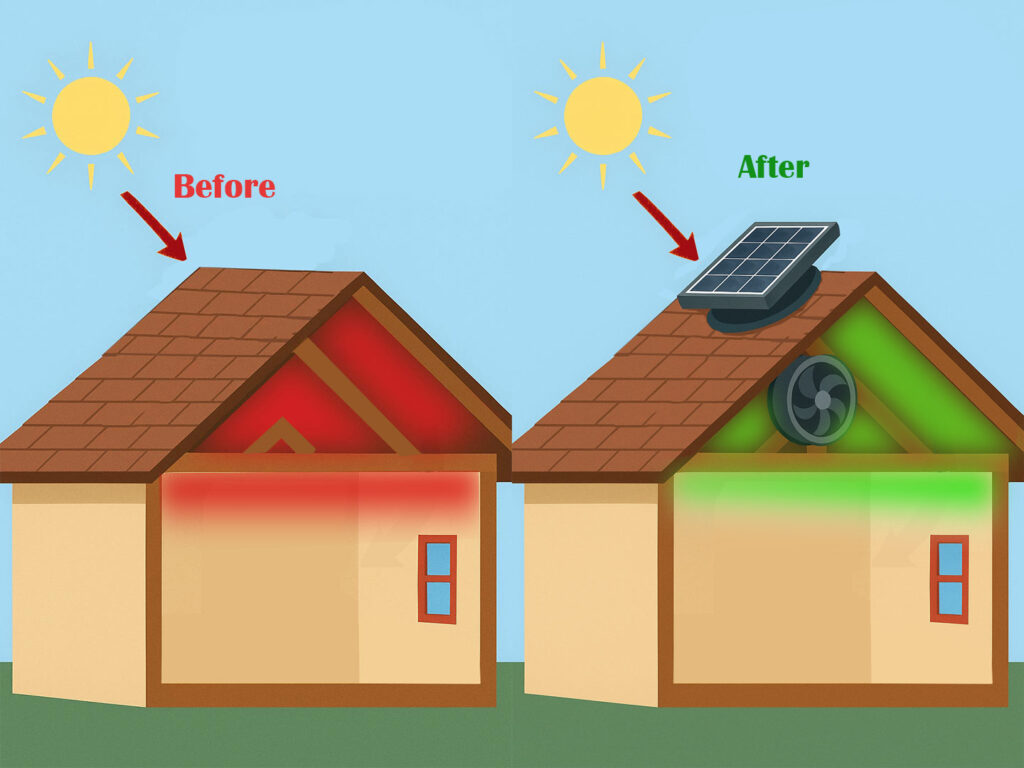What really happens in your attic during severe heat?
On a hot day, your roof can bake like a parking lot. Sunlight superheats the roofing and roof deck, and the attic air becomes a heat reservoir. In many homes, attic temperatures climb well above outdoor air—often into the 120–150°F (49–66°C) range. That stored heat:
- Conducts downward through the ceiling into bedrooms and hallways, making the home feel stuffy and unevenly cooled.
- Overworks your AC. Your AC needs more power to cool down your home, raising your electricity cost.
- Increases nighttime “heat soak.” Even after sunset, a hot attic continues radiating heat into the living space, delaying cooldown.
- Stresses roofing materials. Extreme temperatures can accelerate shingle aging and shorten the life of underlayments and sealants.
- Pairs badly with moisture. In humid climates, trapped warm air holds more moisture, which can aggravate odor, mold risk, and decking expansion if ventilation is poor.
How an attic fan helps keep the attic (and home) cooler
An attic fan is a powered exhaust mounted high on the roof or gable. When it runs, it pulls outside air in through soffit vents (intake) and expels hot air out of the attic (exhaust). Done right, this:
- Drops attic air temperature by continuously flushing out accumulated heat (often a double‑digit °F reduction versus an unvented hot attic).
- Cuts ceiling heat gain so rooms below feel more even, and the AC cycles less.
- Protects components in the attic—from ductwork to stored items to roofing—from extreme heat.
- Can help with winter moisture control (when used with a humidistat in some climates), reducing condensation and ice‑dam risk.
A good attic fan system always pairs adequate intake (soffit or lower‑roof vents) with exhaust. Without enough intake, a fan can depressurize the attic and pull conditioned air from the house. Before adding a fan, air‑seal the attic floor (around light fixtures, top plates, plumbing stacks) and verify that soffit vents are open and unobstructed by insulation.

Solar vs. electric attic fans: which is better?
Lets do a quick math. A typical electric fan rated around 300 W running ~10 hours/day for a hot month uses:
- 300 W × 10 hr/day × 30 days = 90 kWh/month.
- At $0.15/kWh, that’s $13.50/month (and ~$27/month at $0.30/kWh).
A solar fan and an electric fan both cost the same, but a solar fan does the same ventilating with no utility cost.
Why solar’s “duty cycle” is a feature, not a bug: The sun’s intensity—and your roof’s heat gain—peaks together. That means a solar fan ramps up exactly when you need the most airflow. At night, the roof cools naturally, so there’s little need for forced ventilation. So you do not need to worry about cooling your attic in the night. If your climate is frequently cloudy or you want after‑hours ventilation, some solar attic fans accept an optional AC adapter. You get solar savings by default, with grid backup only when you choose.
Attic heat is one of the most overlooked reasons homes feel uncomfortable and AC bills spike. A correctly sized, well‑installed attic fan can lower attic temperatures, reduce heat transfer into living spaces, and lighten the load on your air conditioner. Solar attic fans deliver those benefits with no operating cost, straightforward installation, and quiet, efficient performance—making them the smart, long‑term choice for most vented attics.
